
Acacia acanthoclada, commonly known as harrow wattle, is a low, divaricate, highly branched and spinescent shrub that is endemic to Australia.

Dianella caerulea, commonly known as the blue flax-lily, blueberry lily, or paroo lily, is a perennial herb of the family Asphodelaceae, subfamily Hemerocallidoideae, found across the eastern states of Australia and Tasmania. It is a herbaceous strappy perennial plant to a metre high, with dark green blade-like leaves to 70 cm long. Blue flowers in spring and summer are followed by indigo-coloured berries. It adapts readily to cultivation and is commonly seen in Australian gardens and amenities plantings.

Brachyscome ciliaris, commonly known as variable daisy, is a small bushy perennial herb with a prominent flower, which occurs throughout most of temperate Australia
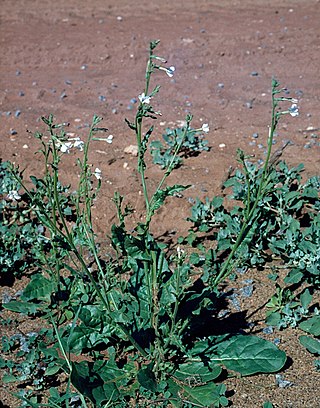
Nicotiana occidentalis, commonly known as native tobacco, is a short-lived herb native to Australia.

Erodium cygnorum is a species of herb native to Australia.

Senecio pinnatifolius is a species of herb native to Australia. Common names include coast groundsel, dune groundsel and variable groundsel.

Lasiopetalum behrii, commonly known as the pink velvet bush, is a species of flowering plant in the family Malvaceae and is endemic to southern continental Australia. It is an erect shrub with lance-shaped, narrowly oblong to narrowly elliptic leaves and groups of white to pink and reddish-brown flowers.
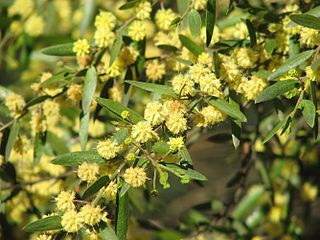
Acacia verniciflua, commonly known as varnish wattle, is a shrub or small tree species that is endemic to Australia. It has an erect or spreading habit, growing to between 1 and 6 metres high, The phyllodes are often sticky and lustrous and vary in length, width and shape. The globular pale-yellow flowerheads appear in the leaf axils from July to November, followed by seedpods that are up to 10 cm long and unconstricted. These contain shiny black seeds. It is often found growing alongside Eucalyptus obliqua where it can dominate the understory.
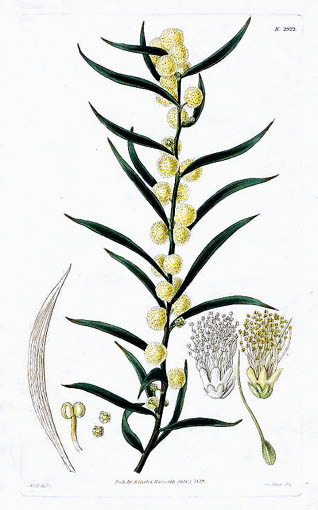
Acacia lanigera, commonly known as woolly wattle or hairy wattle, is a tree species that is endemic south eastern Australia.

Pomaderris paniculosa, commonly known as scurfy pomaderris, is a species of flowering plant in the family Rhamnaceae and is native to Australia and New Zealand. It is a shrub with hairy branchlets, round to elliptic or egg-shaped leaves with the narrower end towards the base and panicles of hairy, cream-coloured to greenish, sometimes crimson-tinged flowers.

Hibbertia fasciculata is a species of flowering plant in the family Dilleniaceae and is endemic to south-eastern Australia. It is a small erect to spreading shrub with glabrous stems except on new growth, narrow linear leaves, and yellow flowers arranged in leaf axils, with eight to twelve stamens surrounding three carpels.
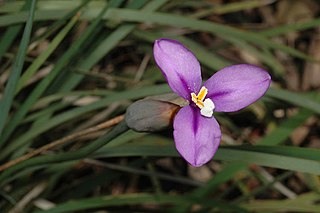
Patersonia occidentalis, commonly known as purple flag, or long purple-flag, is a species of flowering plant in the family Iridaceae and is endemic to southern Australia. It is a tufted, rhizome-forming perennial with narrow, sharply-pointed, strap-like leaves, egg-shaped, bluish violet sepals and a cylindrical capsule. The Noongar name for the plant is komma.
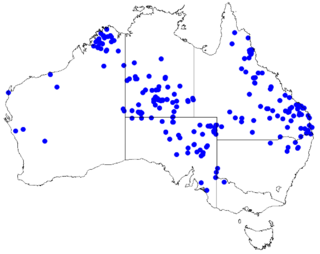
Wahlenbergia queenslandica is a small herbaceous plant in the family Campanulaceae native to Western Australia, to New South Wales, Queensland, the Northern Territory, and South Australia.
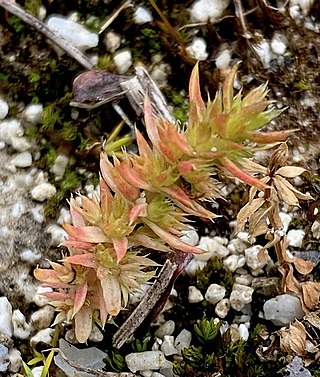
Crassula alata is a herb in the family Crassulaceae. It is native to the Mediterranean basin and is now also found in southern Australia and New Zealand. The succulent annual herb typically grows to a height of 5 centimetres (2.0 in). It produces white flowers in the spring time between August and October in the southern hemisphere.
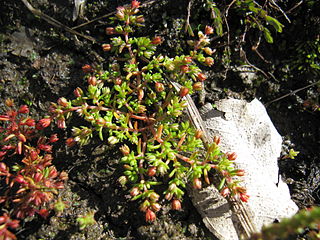
Crassula decumbens, commonly known as rufous stonecrop, cape crassula or spreading crassula, is a herb in the family Crassulaceae that is native to southern parts of Australia, South Africa, and Chile. There are generally two accepted varieties: Crassula decumbens var. decumbens and C. decumbens var. brachyphylla.

Sclerolaena birchii, commonly known as galvanised burr, is a perennial shrub native to inland Australia.

Carex fascicularis, commonly known as tassel sedge, is a species of sedge of the family Cyperaceae that is native to Australia, New Zealand and New Guinea.
Carex tereticaulis, also known as basket sedge, is a species of sedge of the family Cyperaceae that is native to southern parts of Western Australia, southern parts of South Australia, southern and eastern parts of New South Wales as well as north western and central Victoria and Tasmania. The Koori peoples know the plant as Poong'ort.

Pimelea curviflora, also known as curved rice-flower, is a shrub in the family Thymelaeaceae and is endemic to Australia. It is a small, hairy shrub with greenish-yellow or red tubular flowers.

Olearia minor, is a small flowering shrub in the family Asteraceae. It has alternate leaves and white to pale mauve daisy-like flowers from winter to December. It grows in Western Australia, South Australia, New South Wales, and Victoria.


















